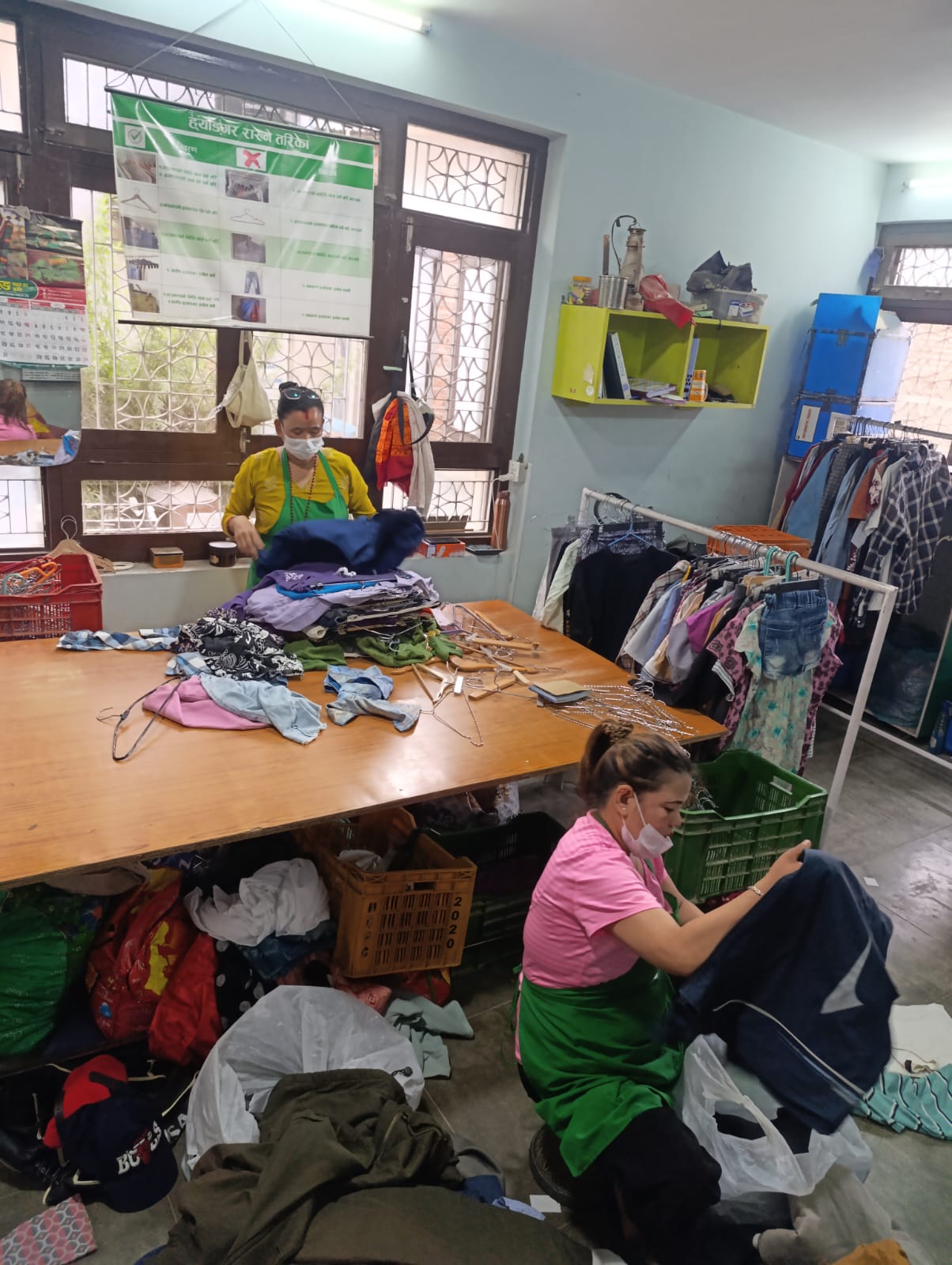Culture & Lifestyle
Fast fashion is cheap, but its real cost is far greater
As TikTok trends and imports flood the market, Nepal faces a choice: follow the fast fashion model or invest in sustainable alternatives.
Aarya Chand
Fast fashion has been quietly reshaping how Nepalis shop and dress. From TikTok-driven trends to the flood of cheap imports from China, India, and Thailand.
Just as this culture of ‘wear and throw’ spreads faster than ever, a new wave of industrial interest is brewing, threatening to deepen the crisis. With the United States imposing steep tariffs on garments from India and Bangladesh, international brands are now eyeing Nepal as the next low-cost garment hub. Indian companies, too, see Nepal as an opportunity. But what seems like economic potential carries heavy risks. For a country already struggling with waste and weak regulation, this combination of fast fashion consumption and industrial garment production could mean pollution, exploitation, and a future that looks more like Bangladesh’s garment crisis than a success story.
This is not just a debate about trade policy or business opportunity. It is about how fast fashion shapes lives, environments, and economies in Nepal. From sustainable entrepreneurs to thrift advocates, from conscious buyers to local shopkeepers, perspectives converge on one reality: fast fashion is cheap, but its real cost is far greater.
“People don’t realise that Nepal could soon become a dumping site of garment waste,” says Rewati Gurung, founder of Kokroma, a social enterprise that produces cotton children’s clothing. Gurung’s work is rooted in reviving traditional practices of making clothes that were once crafted with care and natural materials. For her, sustainable fashion means much more than eco-friendly fabric; it is about community, circularity, and responsibility.
Kokroma’s garments are produced entirely within the Kathmandu Valley, from weaving and dyeing to finishing, keeping the carbon footprint low. Fabric scraps are upcycled into quilts and mattresses, ensuring a zero-waste process. But while Gurung believes that sustainable businesses can thrive, she worries about greenwashing by fast fashion companies pretending to be ethical. “That harms us more than competition itself,” she says.
Like Gurung, Priya Sigdel, co-founder of HattiHatti Nepal, frames fashion as a broader lifestyle choice. “For us, it has always been about conscious consumption in every aspect of life,” she says. HattiHatti employs women from marginalised communities and differently-abled individuals, turning textile waste into tote bags, accessories, and clothing. Their model combines empowerment with recycling, redefining fashion as a tool for inclusion and environmental care.
Both entrepreneurs see hope. Gurung believes Nepali consumers will eventually shift toward refined, meaningful choices, just as people in Australia moved away from fast fashion after two decades. Sigdel envisions sustainable fashion moving from niche to mainstream in five to ten years, supported by policy incentives and consumer awareness.
But both also see the risks of inaction. Without regulation, Nepal could end up bearing the brunt of the world’s garment waste while its own traditions and environment pay the price.
If the warnings of entrepreneurs feel abstract, the work of ‘Sukhawoti Store’ makes them tangible. Founded in 2016, the store runs five outlets in Kathmandu Valley and one in Pokhara, selling secondhand and upcycled clothes, shoes, books, and household items. Donations come from households, drop-off boxes, and free pick-up services.
In less than a decade, Sukhawoti has reused or recycled over 152 tonnes of textiles, preventing them from ending up in landfills. Yet, as CEO Chitra Dahal explains, the rise of cheap, imported fast fashion from China and Thailand has complicated their mission. “We are overwhelmed by donations, but a large portion is poor-quality and unsellable,” he says. Sorting and disposal costs have risen sharply, eating into their already thin margins.
The environmental burden is immense. Synthetic clothes that cannot be resold end up dumped or burned, releasing toxins into the soil, rivers, and air. Microplastics seep into water systems, while chemical dyes create toxic runoff. Nepal’s waste management system, already fragile, cannot keep up.

Recycling and upcycling offer solutions—diverting textiles from landfills, reducing pollution, and creating local jobs—but infrastructure is lacking. Nepal has no large-scale textile recycling facilities, leaving enterprises like Sukhawoti to struggle alone. Meanwhile, cultural stigma still lingers: secondhand clothes are often seen as symbols of poverty, despite growing acceptance among younger consumers.
Dahal calls for systemic solutions: better waste infrastructure, government support for recycling businesses, and a “green tax” on imported fast fashion. Without these, he fears Nepal will drown in clothes it cannot handle.
Not all consumers ignore these problems. Lekhani Niraula, a research fellow at SAARC, who regularly buys secondhand clothes, sees fashion as personal and meaningful. For her, wearing her father’s shirt or finding a thrifted dress at a fraction of its retail price is both affordable and eco-friendly. “It’s like a treasure hunt,” she says. For Niraula, sustainability is not about sacrifice but creativity—mixing vintage with thrift finds to build a unique style.
But she admits to being frustrated at how thrifting is being commercialised. Some stores mark up secondhand clothes so much that buyers wonder if new fast fashion items are cheaper. For a movement meant to make clothes affordable and accessible, this drift toward profiteering feels like a betrayal.
Meanwhile, fast fashion retains its grip on many young consumers. Payal Prasai, an undergraduate student at King’s College, buys trendy clothes from Chinese and Indian wholesalers because they are cheap and ever-changing. Social media platforms like TikTok and Instagram fuel demand for new looks every season. Environmental impact rarely crosses her mind. “Honestly, most of us don’t think about that while shopping,” she says. “We care more about price and looks.”
If sustainable clothes were more affordable, Prasai admits she might shift. But until then, the choice between a Rs250 shirt and an Rs1,500 ethical alternative is easy for most of her peers.
Local retailers are caught between consumer demand and systemic shifts.
Radhika Gaire, owner of Radhika Fancy Shop in Koteshwar, has been selling clothes for eight years. At first, business was good. She kept her margins low, hoping to provide affordable clothing to customers. But with Chinese suppliers flooding the market with ultra-cheap clothes, competition has driven profits down.
“Customers don’t want branded clothes,” she says. “They want the cheapest option, wear it two or three times for TikTok videos, and then move on.” She now sells more Rs250 home wear than anything else, even though she stocks items worth Rs3,000. Quality is secondary to price.
For wholesalers like Kundan Shah of Sasto Bazaar in New Baneshwar, fast fashion is a system. Agents buy unsold lots from Chinese markets at half price and import them to Nepal, where they pass through distributors and retailers. It is a supply chain designed for volume, not longevity. Shah sees little threat from sustainable fashion. “What affects us is online business, not this,” he says. For him, as long as demand for cheap clothes remains high, the business model will survive.
The rise of fast fashion in Nepal mirrors global trends but with sharper edges. Nepal lacks the industrial infrastructure of Bangladesh or China, but it faces similar environmental vulnerabilities. Without strong policies, imported clothes flood the market, outcompeting local producers while leaving behind waste that the system cannot manage.
Entrepreneurs like Gurung and Sigdel are building alternatives rooted in tradition, community, and responsibility. Enterprises like Sukhawoti Store show that circular economies can work but need systemic support. Conscious buyers like Niraula are proving that sustainability can be practical and personal. Yet, the pull of cheap fashion—fueled by social media, peer pressure, and affordability—keeps young buyers like Prasai loyal to fast fashion racks.
The government stands at a crossroads. It can encourage short-term industrial growth by attracting garment production or invest in long-term resilience by supporting sustainable industries, recycling infrastructure, and consumer awareness. The choice will shape not just Nepal’s economy but also its environment, culture, and identity.
In the end, the debate over fast fashion in Nepal is not about trends but about values. Do we measure progress by the volume of clothes produced and consumed, or by the health of our rivers, the dignity of our workers, and the creativity of our communities?
As Nepal is drawn into global supply chains, the risk of becoming another hub of pollution and waste grows real. But so too does the possibility of charting a different course—one where fashion is not disposable, but durable; not exploitative, but empowering; not imported, but rooted in Nepali soil.
The clothes we wear tell stories. The question is whether Nepal wants its story to be one of endless consumption and waste—or one of resilience, responsibility, and renewal.




 14.12°C Kathmandu
14.12°C Kathmandu













%20(1).jpg&w=300&height=200)

